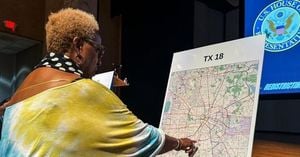The opening of the U.S. Supreme Court’s new term on October 6, 2025, promises to be anything but routine. As the traditional “Oyez! Oyez! Oyez!” rings through the marble halls, the justices face a docket brimming with cases that could reshape the nation’s laws on voting rights, campaign finance, and the very definition of fairness in sports. Behind the legal jargon and procedural wrangling, the term’s central theme is clear: the ongoing struggle to balance the ideals of equality, representation, and individual rights in a country still wrestling with its past.
One of the most closely watched cases is Louisiana v. Callais, a legal battle that could have sweeping consequences for how states draw their congressional districts and for the future of the Voting Rights Act. According to The Heritage Foundation, the controversy began with Louisiana’s post-2020 Census redistricting, which resulted in only one majority-Black congressional district out of six, despite the state’s significant Black population. The NAACP and other groups challenged the map, arguing it diluted Black voting power and violated Section 2 of the Voting Rights Act. A federal judge agreed, ordering the state to redraw the map to include two majority-Black districts. But when the new map was challenged as an unconstitutional racial gerrymander, a three-judge panel sided with the challengers in April 2024. The Supreme Court, however, allowed the map to stand temporarily—citing the need for stability ahead of the presidential election—and scheduled further arguments for the next term.
On June 27, 2025, instead of issuing a final decision, the justices called for new arguments focused on whether intentionally creating a second majority-Black district violates the 14th or 15th Amendments. This move, as reported by Alabama Reflector, has sent shockwaves through the civil rights community. The case’s outcome could redefine the boundaries of legal redistricting and determine whether race can be a factor in ensuring fair representation for minority voters—not just in Louisiana, but across the nation.
The reverberations of this case are felt acutely in neighboring Alabama, where the state’s long history of voter suppression is under renewed scrutiny. In May 2023, U.S. Circuit Judge Stanley Marcus and two colleagues ruled that Alabama’s 2023 congressional map discriminated against Black voters by limiting their ability to elect preferred candidates. When Alabama Solicitor General Edmund LaCour argued that judicial review should only apply after repeated violations, Judge Marcus shot back, “The state of Alabama shouldn’t be divorced from its history, should it?” As Alabama Reflector’s Brian Lyman points out, Alabama’s record from 1901 to 2025 is littered with obstacles to Black voting—obstacles only removed by federal or judicial intervention.
This historical context is crucial. In 2013, the Supreme Court struck down Section 5 of the Voting Rights Act, ending federal preclearance for states like Alabama with a legacy of racial discrimination. Since then, Alabama has enacted laws banning drop boxes for voters with disabilities and criminalizing some absentee ballot assistance. When ordered in 2023 to draw two districts where Black voters could elect their preferred leaders, the Legislature responded with a map that fell short—deliberately, as House Speaker Nathaniel Ledbetter admitted, in hopes of prevailing at the Supreme Court. For now, the Court has ordered Alabama to keep the current map through the 2030 Census, but the fate of similar districts nationwide hangs in the balance as the justices weigh the Louisiana case.
While voting rights dominate the headlines, the Supreme Court’s term is also set to tackle the contentious intersection of sports, gender identity, and equal protection. In West Virginia v. B.P.J., the justices will decide the fate of the state’s Save Women’s Sports Act, passed in 2021. The law mandates that participation in female sports be determined by biological sex, citing concerns about fairness and competitive advantage. The law was challenged by “Becky” Pepper-Jackson, an 11-year-old athlete who is biologically male but identifies as female. Her family argued that the law violates the 14th Amendment and Title IX, which prohibits sex-based discrimination in education.
After a district court initially sided with West Virginia, the 4th U.S. Circuit Court of Appeals reversed the decision in April 2024, allowing B.P.J. to compete and ruling the law’s exclusion as a violation of Title IX. West Virginia appealed to the Supreme Court, and the outcome could trigger a domino effect, impacting similar laws in more than two dozen states. As The Heritage Foundation notes, the stakes are high: a ruling against West Virginia could mark a generational turning point for women’s sports and the definition of gender in American law.
Idaho’s Little v. Hecox poses a similar, but even deeper, constitutional question. The state’s Fairness in Women’s Sports Act, the first of its kind in the U.S., bans biological males from playing in women’s sports. Plaintiffs Lindsay Hecox, a transgender athlete, and an anonymous Jane Doe, sued on the grounds that the law violates the equal protection clause of the 14th Amendment. A federal judge granted an injunction in August 2020, and the 9th U.S. Circuit Court of Appeals affirmed the decision in 2023, finding the law discriminatory. On July 3, 2025, the Supreme Court agreed to hear the case. The decision could not only affect sports laws nationwide but also challenge fundamental notions of identity and constitutional protection.
Campaign finance is also on the docket. The National Republican Senatorial Committee v. Federal Election Commission case asks the Court to reconsider federal spending limits on political parties in coordinated campaign activities—a precedent set in 2001. The National Republican Senatorial Committee and Senator JD Vance argue these limits violate the First Amendment. Lower courts have upheld the previous ruling, but the Supreme Court’s willingness to revisit the issue signals that the justices may be open to reshaping the boundaries of political spending and free speech in campaigns.
These cases are just a sampling of the three dozen the Court has accepted for the term so far. More are expected as the justices return from their summer recess and sift through thousands of petitions. The stakes are enormous—not just for the litigants, but for millions of Americans whose rights and representation hang in the balance. The decisions could alter the landscape of voting rights, redefine fairness in sports, and recalibrate the influence of money in politics.
With the Supreme Court poised to decide questions that cut to the core of American democracy, the coming term promises to be one for the history books. Each case offers a window into the nation’s ongoing struggle to reconcile its ideals with its realities, and the outcomes will shape the legal and cultural landscape for years to come.




